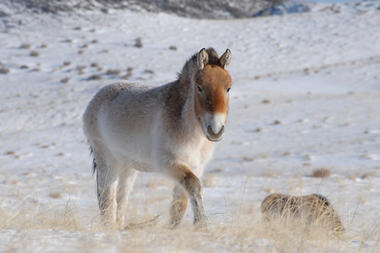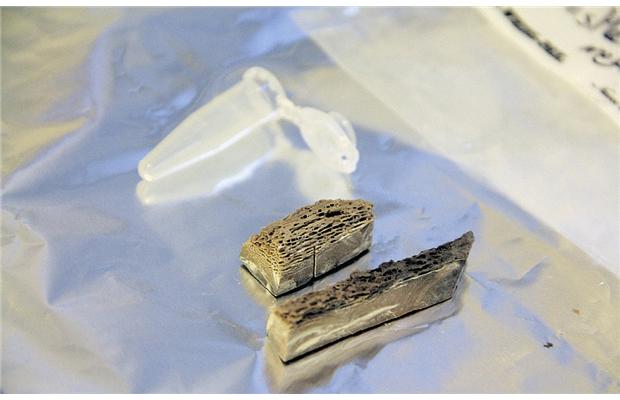November 12, 2013 – I have written in the past about attempts to reconstruct the DNA of the Woolly Mammoth, one of the most imposing creatures that wandered the landscape of North America and Eurasia at the height of the Ice Age. Well it seems that Russian and South Korean cloning experts have been beaten to the punch by researchers at the Centre for GeoGenetics, the Natural History Museum of Denmark who have reconstructed the genome of a horse that was native to the Canadian Arctic plains over three-quarters of a million years ago. The horse may have appeared similar to Przewalski’s horse, a wild species still found in western Mongolia (see picture below). The extinct horse, however, was much larger like so many of the animals during the Ice Age.
Using a next-generation DNA sequencer the researchers analyzed thousands of DNA fragments found in bony remains (see image below) buried in the permafrost of the Yukon Territory in Canada. From that they were able to recreate a fully constructed genome. Horses in North America became extinct after the last Ice Age and were reintroduced by the Spanish in the 16th century.
In addition to the work of the Danish team, a separate group have also succeeded in reconstructing the DNA of a giant cave bear that lived in northern Spain some 400,000 years ago. The latter’s remains were discovered in what obviously is a much warmer climate than the Yukon. As a result the remains had suffered more extensive decomposition, but the researchers used DNA from the bear’s mitochondria to regenerate the genome.
Both the bear and horse represent a huge advancement in genetic reconstruction. Prior to these two teams’ success the oldest reconstructed genetic information dated back less than 100,000 years. For genome reconstruction this means many new possibilities. Will we try to recreate our human ancestors like Neanderthal or Homo Erectus? Will we recreate the genome of other extinct Ice Age creatures? And as we perfect this technology can we go back even further in time and reconstruct the genome of the mammals of the Cenozoic or the dinosaurs of the Cretaceous? Are we beginning down a path to “Jurassic Park?” Because once we have the genome what’s to stop us from bringing back the species?


















This theory is more logical than Darwin’s.
Charles Darwin didn’t know about DNA. He hadn’t read any of the research done by Gregor Mendel who showed us in pea plants how inherited traits are passed from generation to generation. But if he were to have been given a chance to see these scientific discoveries, it would have reinforced the conclusions he drew from observing the finches of the Galapagos and other creatures throughout the voyage of the Beagle. So, what this article describes is thoroughly consistent with Darwin’s description of how species adapt to the environments in which they live.